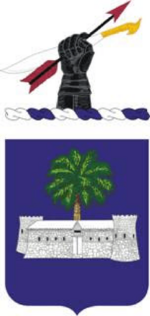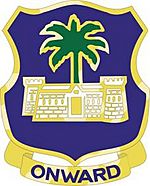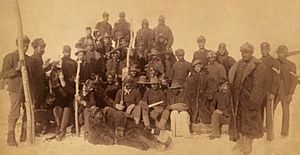25th Infantry Regiment (United States) facts for kids
Quick facts for kids 25th Infantry Regiment |
|
|---|---|

Coat of arms of the 25th Infantry Regiment
|
|
| Active | 1866–1957 |
| Country | |
| Branch | |
| Type | Infantry |
| Size | Regiment |
| Motto(s) | "Onward" |
| Colors | Blue for Infantry |
| Engagements | Indian Wars Spanish–American War Philippine–American War World War II |
| Insignia | |
| Distinctive unit insignia |  |
The Twenty-fifth United States Infantry Regiment was a special unit in the United States Army. It was one of the "Buffalo Soldier" regiments. These units were made up of African-American soldiers. The 25th Regiment served from 1866 to 1957. They fought in the American Indian Wars, the Spanish–American War, the Philippine–American War, and World War II.
Contents
- The Start of the 25th Infantry Regiment
- Campaigns and Major Battles
- Notable Soldiers and Officers
The Start of the 25th Infantry Regiment
After the American Civil War, the U.S. Army grew bigger. Congress decided to create four new regiments. These regiments were for "Colored Troops." This meant they had white officers and African-American enlisted soldiers. Many of these soldiers were veterans from the Civil War. This was the first time the regular U.S. Army had non-white regiments. The U.S. Army kept these separate units until 1950.
In 1869, Congress made the army smaller. The 39th and 40th Regiments joined together. They became the 25th Infantry Regiment. In April 1869, the 25th set up its first base. It was at Jackson Barracks in Louisiana. Colonel Joseph A. Mower was their first commander.
Serving in the Indian Wars
In May 1870, the regiment moved to San Antonio, Texas. Soon, its companies spread out. They went to small forts in west Texas. These included Fort Bliss, Clark, Davis, and Stockton. For ten years, the 25th guarded the Mexican border. They also built roads and telegraph lines. Sometimes, they fought against Native American groups. In 1878, some soldiers even went into Mexico.
In 1880, the 25th moved north. They operated in Dakota Territory, Montana, and Minnesota. In Minnesota, they were based at Fort Snelling. Parts of the 25th took part in the Pine Ridge Campaign. This was one of the last major conflicts with Native Americans. It happened in 1890–91. Later, in 1894, some companies helped stop a railroad strike.
The 25th Infantry Regiment Bicycle Corps
In 1895, General Nelson A. Miles had a new idea. He wanted to see if soldiers could use bicycles. Lieutenant James A. Moss led a volunteer group from the 25th. They tested how well bicycles worked for long trips. Their first trip was 126 miles to Lake McDonald. It took four days. The cyclists carried about 120 pounds of supplies. They also had 50 pounds of ammunition. They faced rough roads, steep hills, and mud. They also had to fix their bicycles often. But the trip was a success!
Six days later, they went on a 325-mile trip. This trip was to Fort Yellowstone. They rode about 45 miles each day. It took them 8 and a half days to reach Yellowstone. The men carried extra food and supplies. This made their bicycles even heavier. They had many flat tires and other problems. The mud also made it very hard to ride.
Long-Distance Bicycle Journey
After more practice, the 25th tried a huge trip. They rode from Fort Missoula to St. Louis, Missouri. This was a 1,900-mile journey! They went through different climates and terrains. Wet and dry areas each caused problems. Twenty men who were fit enough went on the trip. A doctor and a journalist also joined them. They started on June 14, 1897.
The group faced many challenges. They were thirsty, hungry, and tired. They dealt with bad water, cold, and heat. They went from snow in the Rocky Mountains to warm lowlands. Contaminated water made some members sick. Lieutenant Moss even had to catch a train to rejoin the group. Muddy roads also slowed them down. The men often had to carry their bicycles through the mud. Lieutenant Moss guessed they had to get off their bikes every seven miles. They finally reached St. Louis on July 24. Locals and other cyclists celebrated their arrival.
Lieutenant Moss wanted to ride to St. Paul, Minnesota next. But his request was denied. The men traveled back to Fort Missoula by train. In February 1898, Lieutenant Moss asked for another trip. He wanted to ride from Fort Missoula to San Francisco. But the Spanish–American War started in April 1898. The 25th Regiment was sent to Cuba. All future bicycle tests were canceled. The U.S. Army later used motorcycles and cars instead of bicycles.
Fighting in the Spanish–American War
In spring 1898, all four "colored" regiments moved to Florida. They were getting ready for war with Spain. They joined Major General William R. Shafter's V Corps. This group went to Cuba to capture Santiago de Cuba.
The 25th Regiment took part in the attack on El Caney. This happened on July 1, 1898. Brigadier General Henry W. Lawton led the attack. Soldiers from the 25th were among the first to reach the top of the hill. Private T.C. Butler was the first to enter a Spanish building. He captured the Spanish flag. But an officer from another regiment told Butler to hand over the flag. That regiment later claimed they captured it. The 25th's commander, Lieutenant Colonel A. S. Daggett, protested this. When the Spanish surrendered on July 14, the 25th was closer to Santiago than any other unit.
Serving in the Philippine–American War
In 1899, the 25th returned from Cuba. They went to bases in the southern Rockies. Later that year, they sailed to the Philippine Islands. They helped fight against the Philippine nationalist movement. This movement was led by Emilio Aguinaldo. The 25th returned to the U.S. in 1902.
The Brownsville Affair
In 1906, 167 soldiers from the 25th Infantry were dismissed from the army. They were accused of shooting at white people in Brownsville, Texas. They were not given a trial. In 1972, it was found that the soldiers were innocent. The order from 1906 was then reversed.
Helping with the Great Forest Fires of 1910
In the summer of 1910, many forest fires broke out. They were in northern Idaho, western Montana, and eastern Washington. Dry weather, strong winds, and lightning caused hundreds of fires. The U.S. Army sent help. Company G of the 25th Infantry Regiment was sent to Avery, Idaho. They arrived on August 17, 1910. For four days, they fought the fire threatening the town.
On August 21, the fire grew very large. Strong winds pushed it, and it joined other fires. The town of Avery had to be evacuated. The soldiers of the 25th Infantry Regiment were key in helping hundreds of townspeople escape safely. A few days later, the fire ended. Over three million acres had burned. After the fire, the soldiers helped clean up. They also searched for people who had died in the fire. Historians say the Buffalo Soldiers saved Avery. They built a "back" fire that stopped the main fire. Their quick thinking saved the town.
World War I and World War II Service
During World War I, the 25th Regiment was stationed in Hawaii. They did not see combat.
In World War II, the 25th Infantry Regiment (Colored) was part of the 93rd Infantry Division (Colored). They served in the Pacific Ocean area. The regiment left San Francisco in January 1944. They arrived on Guadalcanal by March 1944. From there, they moved to Bougainville. They helped fight against Japanese forces in April and May.
Later, the regiment was on the Green Islands. They trained more and built defenses. From November 1944 to March 1945, they defended Finschafen in New Guinea. Their last move in World War II was to Morotai Island. They arrived there by April 1945. They continued fighting until the war ended. For their service in World War II, the 25th Infantry Regiment received credit for campaigns in the Northern Solomons, Bismarck Archipelago, and New Guinea. The regiment was officially stopped from active duty in California in February 1946. A few years later, President Harry Truman ordered all U.S. military units to be desegregated. This ended all separate units in the American armed forces.
After World War II
The 25th Infantry Regiment was reactivated in February 1946. This happened at Fort Benning in Georgia. Another unit, the 107th Regimental Combat Team, was also activated. It included infantry, artillery, tanks, and engineers. In March 1946, the 107th was renamed the 25th Regimental Combat Team (Colored). Colonel Robert L. Dulaney, a World War II veteran, became its first commander.
In April 1946, the regiment marched in the Army Day parade. This was in Washington, D.C.. They represented all veterans from WWI and WWII. In May 1946, the 25th Regimental Combat Team grew. It now had about 4,000 soldiers. In November 1946, the regiment started a new education program. It helped soldiers who had less than an 8th-grade education. About 1,900 soldiers started this program.
The Cold War Era
The 25th Regimental Combat Team was now at full strength. It began to support the 24th Infantry Regiment (Colored). The 24th was serving in Japan. The Army wanted to try something new. They planned to integrate the 24th Infantry Regiment into a white division. This was the 25th Infantry Division. To make the 24th stronger, soldiers from the 25th Infantry Regiment were transferred. Over 20 officers and 515 soldiers from Fort Benning went to Japan. They arrived in late February 1947.
In March 1947, the 25th Infantry Regiment received its World War II campaign streamers. These were for New Guinea, Northern Solomons, and Bismarck Archipelago. In February 1947, the regimental combat team structure changed. The 25th Infantry Regiment continued as a smaller unit. It had two rifle battalions instead of three. The regiment celebrated its 78th Anniversary in May 1947. It had fought in four wars. These included the Indian Wars, the War with Spain, the Philippine Insurrection, and World War II. In July 1947, one of its units, the 571st Field Artillery Battalion, moved to Fort Riley, Kansas.
Campaigns and Major Battles
Notable Soldiers and Officers
- Carroll Augustine Devol (1859–1930)
- Lewis Broadus (1897-1917)
- Gilbert W. Lindsay (1900–1990)
- Dobie Moore
- Clarence Leonard Tinker (1887–1942)
- Bullet Rogan
- Prince Romerson (c. 1840–1872), a Native Hawaiian soldier who also fought in the Civil War.


